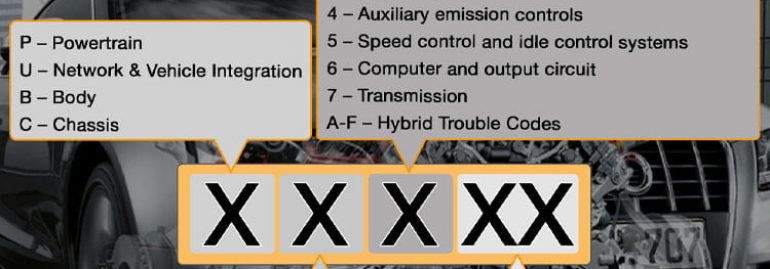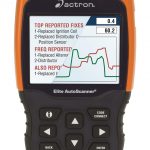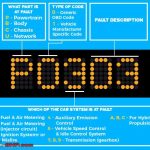What are the different types of car fault codes? These codes are grouped according to their function in the car. Some are OBD2 while others are SAE. Learn what each one means and how to identify them with your car’s dashboard. Moreover, learn about how these codes are related to your car’s system. Listed below are some common car fault codes:
OBD2
OBD2 car fault codes are part of the self-diagnosing system of the vehicle, and their purpose is to indicate a malfunction to the mechanic or driver. These codes are also known as Check Engine Light Codes or Diagnostic Trouble Codes. These codes are essential for drivers and mechanics alike. However, there are some things you should know before you can properly troubleshoot your vehicle. Below, you’ll find some tips to help you interpret the meaning of these codes.
OBD2 car fault codes come in three different categories. P stands for powertrain, which covers the engine, transmission, and related accessories. U stands for network & vehicle integration, which refers to computer systems onboard the car. C stands for chassis, which covers the mechanical systems of the car, and T – undefined. Some codes are more general than others, while some are manufacturer specific. Luckily, they’re not difficult to interpret.
Some of the most common OBD2 car fault codes involve the engine. Code P0302 means the engine misfired on cylinder 2. But the problem could also come from other parts of the car. If your car’s IAT sensor is not functioning properly, this could lead to a misfire. You can also get other OBD2 codes to identify specific problems with your car. These codes are helpful for diagnosing car problems yourself. Fortunately, you can purchase a hand-held code scanner and scan the vehicle yourself. These scanners have clear codes and require only a small amount of information to read.
If you’re looking for a quick and easy fix to your car’s problem, there are several resources available to help you find the problem. Having a good OBD2 reader can help you get to the root of the problem, so that you can start working on the car. A reliable reader can also detect trouble codes beyond DTCs. When your car’s computer reads the codes, the computer will be able to pinpoint any issues before they get out of hand.
Another common OBD2 car fault code is P0132. This indicates that the TPS voltage is lower than its minimum value. This could be as low as 0.20V. If you suspect this problem, visual inspection of the wiring can show if there are loose connections or poor connections. Finally, the P0131 code triggers when there is low voltage in the bank 1 sensor. This code is an indication of a malfunctioning part.
SAE
Most of the time, error codes are the result of a system failing to meet the standards of a regulatory body. These regulatory bodies include the Society of Automotive Engineers (SAE) and the International Standard of Organization (ISO). These codes are also called service procedures and are used to diagnose malfunctions in cars and other vehicles. There are two types of fault codes: generic and manufacturer-specific. For example, codes that start with “P0” are powertrain problems, while those that start with P1 are a mass air flow sensor issue.
To diagnose an engine malfunction, you need to know what SAE car fault codes mean. Luckily, a lot of the fault codes are easy to understand and can be found by following the instructions in the user’s manual. In this article, I’ll explain how to interpret each code and what it means. The first step in diagnosing an error code is to check the TSBs (technical service bulletins). Once you’ve found out what your vehicle is saying, you can take the next step.
Generally speaking, SAE car fault codes are broken down into three different categories. First, there are generic codes and SAE car fault codes. These generic codes refer to universal standards and are widely used by all manufacturers. The generic codes, or OBD codes, are used by most cars. The manufacturer-specific codes are used by individual manufacturers and are not universal. The codes that start with 1 are manufacturer-specific. As their name suggests, these codes are specific to one particular vehicle model.
The second part of the SAE J1587/J1708 code refers to the component that is experiencing the problem. The third character is a digit ranging from 1 to eight. The fourth character is a two-digit number between 0 and 99. The specific fault index is the issue the vehicle is having. The vehicle’s manufacturer or manual may have more detailed explanations of the problem. It is also possible to interpret SAE car fault codes by using the information they contain.
IQDM controller response code
An IQDM controller response code for car faults is A. If it is A, then the controller has detected a throttle fault. This fault is generally caused by an open armature. Specifically, this fault can be detected when the accelerator pedal is almost all the way to the floor, there is no speed sensor pulse, and the current flow is less than 20 amps. If you’re unsure what this fault is, read the owners manual to find out what your vehicle’s response code is and how to repair it.
IQDM controller response codes A and C indicate different faults. A means the motor is stalling, while C means the controller is not receiving enough voltage. A stalling electric motor will overheat the controller. Two other faults are associated with a stuck solenoid, so it’s important to repair this before attempting to repair the controller. A faulty solenoid can damage the controller and damage the motor.
The IQ System Display Module is a handheld diagnostic tool that shows the car’s fault codes. The HPD fault, for instance, is usually identified by the IQDM controller response code A. In this case, the accelerator is depressed while the cart’s key switch is in the ON position. The High Pedal Detect fault, on the other hand, specifies a pedal limit switch failure.
The first digit indicates the manufacturer or SAE generic code. The last three numbers of the code provide information about the circuit or system. OBD II codes, for example, monitor the fuel and air ratio of the vehicle’s engine, and measure emissions and fuel economy. In addition, fuel injector codes are related to the ignition system. Finally, the ignition code is triggered by problems with spark plugs.
P0xxx
If you’ve been unable to start your car due to a P0xxx code, you need to know more about these. Most codes begin with a letter – P, for powertrain. However, you may also see codes with b, c, and u, which refer to a vehicle’s body, chassis, or computer or communications problems. While these codes may not be very useful for you to fix the problem, they are useful for determining if your car is experiencing an issue.
The code is not specific to any particular manufacturer, but may apply to all models. It is possible to have more than one of these codes. For example, P0a is for powertrain issues, whereas P0b means problems with the emission system. While P0b and p0c are generic codes, P1xxx codes are manufacturer-specific. P07xx codes refer to the transmission. The last two digits are the specific problem the vehicle is experiencing. To identify the exact problem, you will need to consult a code chart.
P0xxx car fault codes are a signal that something is wrong with a vehicle. For instance, the O2 sensor may be failing to accurately adjust the air-to-fuel ratio. Then, the P0136 car fault code is caused by a low voltage in sensor 2 bank. Despite a low voltage, this code is not related to an actual faulty component, but rather a system fault.
The P0xxx car fault codes are the result of a malfunction in a non-powertrain system. They’re a common cause of failures in vehicles, but they don’t necessarily affect the powertrain. These codes can be retrieved through the OBDII diagnostic link connector and aren’t associated with the NYVIP2 emissions inspection. These codes are also referred to as pending or maturing. They indicate faults that require two consecutive warm-up cycles.
There are two types of P0xxx car fault codes. The first type is the generic one, which is associated with no apparent problems. The other is the manufacturer-specific DTC. If you find that your car is running in “limp mode,” you’ll have to go to your mechanic, who can diagnose and fix the problem for you. If you’re not sure what to do, the most basic way to diagnose the problem is to get a diagnostic scan tool.







Hi. I have a code $07E8. please could you let me know what it is and if it’s serious.
Kind regards and thank you Graham.